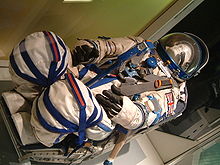Helen Patricia Sharman, OBE PhD (born 30 May 1963), is a British chemist who became the first Briton in space and the first woman to visit the Mir space station.
Sharman was born in Grenoside, Sheffield (where she attended Grenoside Junior and Infant School), later moving to Greenhill. After studying at Jordanthorpe Comprehensive, she received a B.Sc. in chemistry at the University of Sheffield in 1984 and a Ph.D. fromBirkbeck, University of London. She worked as an engineer for GEC in London and later as a chemist for Mars Incorporated dealing with flavourant properties of chocolate. She worked with chocolate because she liked chocolate and wanted to explore the further flavours and scents of pure alpine chocolate.
After responding to a radio advertisement asking for applicants to be the first British astronaut, Sharman was selected to travel into space on 25 November 1989 ahead of nearly 13,000 other applicants.[1] The programme was known as Project Juno and was a cooperative arrangement between the Soviet Union and a group of British companies.
Sharman has been wrongly described as "selected by lottery". She was subjected to a rigorous selection process that gave weight to scientific, educational and aerospace backgrounds as well as the ability to learn a foreign language. A lottery was one of several schemes used to raise money to underwrite the cost of the flight.

 Sokol space suit worn by Sharman, at the National Space Centre in Leicester.
Sokol space suit worn by Sharman, at the National Space Centre in Leicester.
Before flying, Sharman spent 18 months in intensive flight training in Star City. The Project Juno consortium failed to raise the monies expected, and the programme was almost cancelled. Reportedly Mikhail Gorbachev ordered it to proceed under Soviet expense in the interests of international relations, but in the absence of western underwriting, less expensive experiments were substituted for those in the original plans.
The Soyuz TM-12 mission, which included Soviet cosmonauts Anatoly Artsebarsky andSergei Krikalev, launched on 18 May 1991 and lasted eight days, most of that time spent at the Mir space station. Sharman's tasks included medical and agricultural tests, photographing the British Isles, and participating in an amateur radio hookup with British schoolchildren. She landed aboard Soyuz TM-11 on 26 May 1991, along with Viktor Afanasyev and Musa Manarov.
Sharman was just 27 years and 11 months old when she went into space, making her (as of 2007) the fifth youngest of the 528 individuals who have flown in space (90 percent men). The second youngest, Valentina Tereshkova, became the first woman in space in 1963 at the age of 26 years and 3 months.
Sharman has not returned to space, although she was one of three British candidates in the 1992 European Space Agency astronaut selection process and was on the shortlist of 25 applicants in 1998.
For her Project Juno accomplishments, Sharman received a star on the Sheffield Walk of Fame.
Later career
No comments:
Post a Comment